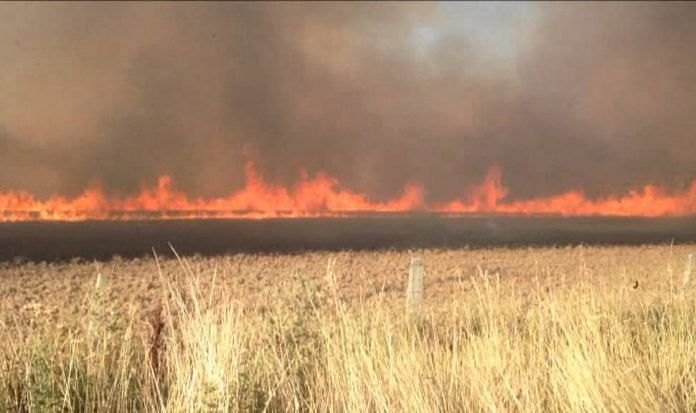The state governments’ initiative to reduce the practice of stubble burning, which is said to cause the smog in Delhi-NCR, seems to have worked well.
Chandigarh: While the jury is still out on if paddy straw burning by farmers in Punjab and Haryana causes the smog that engulfs the National Capital Region (NCR) during this time of the year, sustained intervention that began in the two states last year is showing results. Almost a fortnight into the month-long paddy harvesting season, both states have reported a nearly 50 per cent reduction in the number of stubble burning incidents.
Sharp reduction in Punjab
The reduction in incidents is sharper in Punjab. From 27 September till 10 October, the agriculture department reported over 420 fire events. This number during the corresponding fortnight last year was 1,020, and over 1,415 in 2016.
Paddy is grown over 65 lakh acres in the state, and produces 20 million tonnes of paddy straw. Of this, only 5 million tonnes was being managed, while nearly 15 million tonnes of paddy straw was being burnt for easy clearance of fields. “The effort is to ensure management of the entire 20 million tonnes,” said Kahan Singh Pannu, agriculture secretary of Punjab.
Situation in Haryana
In Haryana, paddy is sown on 13.5 lakh hectares, the maximum area being in the districts of Karnal, Kaithal, Jind, Kurukshetra and Fatehabad.
The agriculture department stated that from 25 September to October 10, paddy stubble burning has been reported from almost 460 sites, involving an area of 735 hectares.
“This was less than one per cent of the total area where harvesting had taken place,” pointed out a government spokesperson. During the same period last year, over 750 active crop fire locations had been identified.
Satellites monitoring fires
Both states have roped in the services of remote sensing centres to live-monitor the fires. “Haryana Space Applications Centre in Haryana Agricultural University campus in Hisar is monitoring the state through satellite. The satellite spots any thermal sensitive information in an approximately 35-acre field,” said Rajbir Singh Chahal, additional director agriculture, Haryana.
Also read: For Punjab’s crusading IAS officer, stubble burning is not behind Delhi’s air pollution
“Every such report may not be stubble burning. The information provided by the satellite is then cross-checked by a district level team and action taken.”
Apart from capturing daily data on live fires, the Punjab Remote Sensing Centre (PRSC) has developed three apps to facilitate farmers: i-Khet for information about availability of machines for in-situ management of crop residue, e-PEHaL for monitoring tree plantation, and e-Prevent to have prompt and accurate information regarding incidents of crop residue burning.
Focus on in-situ management
For two years (2018-2019), Punjab and Haryana are focussing their attention on convincing farmers to incorporate paddy straw within the soil, called in-situ management technique.
“In case after two years we have a microbial technique available, we will shift to that,” said B.S. Sidhu, member secretary of the Punjab State Farmers Commission.
As part of the central government scheme Promotion of Agricultural Mechanisation for IN SITU Management of Crop Residue (sic), which is monitored by the Prime Minister’s Office, Punjab and Haryana have been given special grants to encourage farmers to use specialised machinery that facilitates the in-situ technique.
Punjab has spent Rs 269 crore in providing 50 per cent subsidy to individual farmers and 80 per cent subsidy to groups and cooperatives for the purchase of these machines. Almost 13,300 agriculture machines have been distributed amongst the customer hiring centres, cooperative societies and farmers, against the target of 24,000 machines/equipment, said Pannu.
For Haryana, the Centre allocated Rs 137.84 crore and the state has spent almost 100 crore. It has set up almost 1,210 (of the 1230) Custom Hiring Centres, which have been given subsidised machinery.
“A cluster of villages will hire the machinery from these centres while another 3,000 individual farmers have purchased subsidised implements,” said Chahal.
Village-level intervention
Both states have specialised teams in place at the village level to approach the farmers. In Punjab, nearly 8,000 nodal officers have been appointed in villages — to use social media, short songs and involve school students in convincing the farmers to shun burning paddy straw.
Also read: To stop stubble burning, Punjab makes it mandatory to affix machine to combine harvesters
In Haryana, apart from convincing the farmers, a ‘night watch’ (thikri pehra) has started in villages to self-monitor paddy straw burning. “We have also told sarpanchs in the villages that in case there is a paddy straw burning incident, the village will not be given development grants,” said Chahal.







Praiseworthy.